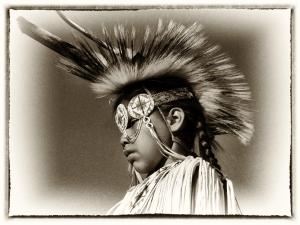Step into my world of poetic imagery - the world of AI art.

It was the summer of 2005 when I met Travis at a Songhees powwow in Victoria BC. His regalia was beautiful and I wanted to photograph him. Since he was a young boy, I thought it prudent to get permission from an adult. I asked a nearby jingle dancer if she knew who his parents were. Come with me, she said. I followed her to an RV. She told her grandmother, He wants to take a picture of Travis. The grandmother sized me up and asked if I'd had lunch. I hadn't. She invited me in to eat with them. She was appreciative of the fact that I asked. Most people don't ask, she said. She was Travis' grandmother, and she had a story to tell.
"I came from a family of seven children. I'm the only one left. The others died, of alcohol, suicide, and one was murdered. I want to protect my grandchildren from a similar fate. That's why they dance. I want them to know who they are and to take pride in their heritage. Travis wears braids. He sometimes complains about being teased at school. But I tell him he is a warrior, and warriors are strong. Warriors are brave and proud of their aboriginal heritage. Warriors practice kindness and patience. Warriors respect their elders."
I was moved by her story. Aboriginal people lost their land, their language and their culture. They were uprooted by a society who felt superior. As a consequence, many suffered as victims of manifest destiny. They bore many of the symptoms that accompany victimization: alcohol abuse, sexual abuse, drug abuse, suicide and a sense of displacement. Dancing is a way to remind us where we've come from, to participate in an identity we've lost, and an identity we've felt a shame to possess. We are still suffering, and that's why I encourage my grandchildren to dance. I don't want them to end up like my brothers and sisters.
Her story moved me. There are many other stories like hers, tragic, and without hope. I trust, in some way, we can share the burden of the aboriginal peoples of the world.